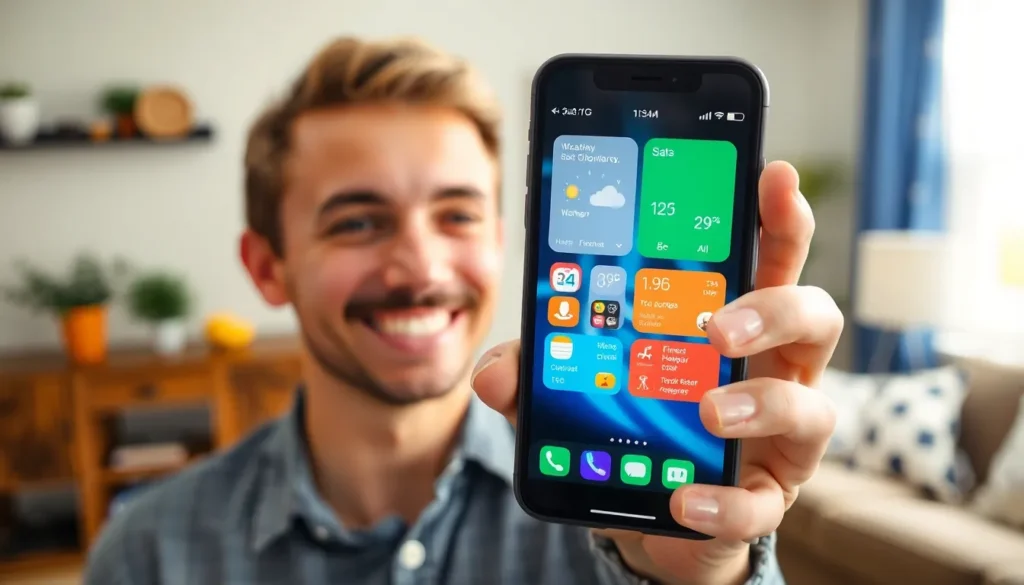If you’ve ever found yourself scrolling endlessly through your iPhone, wondering how to make your home screen more exciting, you’re in for a treat. Enter the magical world of widgets—those nifty little tools that transform your plain app icons into vibrant, information-packed companions. Think of widgets as the stylish accessories for your iPhone, adding flair while keeping you updated at a glance.
Table of Contents
ToggleWhat Is Widget on iPhone
Widgets on iPhone serve as interactive tools that provide essential information at a glance. They enhance the home screen experience by displaying real-time data without opening apps. Users can personalize widgets to show weather updates, calendar events, or fitness stats, making them highly functional.
Widgets come in different sizes: small, medium, and large. Each size offers varying amounts of information and visual appeal. Small widgets may show a single piece of data, while large widgets can display multiple updates simultaneously.
Interactivity is another key feature of widgets. Users can interact with specific information directly through the widget. For instance, tapping on a calendar widget may take users straight to their upcoming events.
Customizability stands out in the widget experience. Users can select from numerous widget types and arrange them according to preference. The simple drag-and-drop method in the widget gallery allows quick adjustments to the home screen layout.
Compatibility with third-party apps also enhances the functionality of iPhone widgets. Many popular apps offer widget support, enriching the home screen with varied content. From social media updates to news headlines, widgets create a dynamic interface.
Availability extends across various iOS versions, particularly from iOS 14 onward, where widgets were significantly redesigned. With this update, users gained more flexibility in combining widgets with their favorite app shortcuts.
Widgets provide a streamlined approach to accessing information quickly and intuitively. By merging aesthetics with functionality, they transform the iPhone experience into something more engaging and efficient.
Types of Widgets

Various types of widgets exist on iPhones, enhancing user experience through functionality and ease of access. Widgets come in several forms tailored for different uses.
Home Screen Widgets
Home screen widgets allow users to personalize their display directly. These widgets can be sized small, medium, or large, providing tailored information at a glance. A calendar widget, for example, shows upcoming events while the weather widget provides current conditions and forecasts. Users can arrange multiple widgets in any order, making their home screen unique to their preferences. Enhanced interactivity enables users to engage immediately, like tapping to launch an app or get more details. Overall, home screen widgets help streamline access to important data.
Today View Widgets
Today view widgets reside on the left side of the home screen, offering quick insights with a simple swipe. Users find this space perfect for gathering various updates in one location. Common widgets include news summaries, fitness tracking, and reminders, each delivering real-time information. They maintain a smaller footprint, ensuring the main home screen remains uncluttered. The drag-and-drop feature promotes easy customization, allowing adjustments based on priorities. Consequently, today view widgets serve as a valuable tool for quick reference and organization.
How to Add a Widget on iPhone
Adding a widget on an iPhone enhances the home screen experience. Users can quickly access information through interactive tools.
Step-by-Step Guide
- Press and hold an empty area on the home screen until the apps jiggle.
- Tap the ‘+’ icon located in the upper left corner of the screen.
- Browse the available widgets and select one.
- Choose a specific size: small, medium, or large.
- Tap “Add Widget” to place it on the home screen.
- Drag the widget to your desired location, then tap “Done” in the upper right corner.
Widgets appear immediately, providing instant access to information.
Customizing Your Widgets
Customizing widgets allows for a tailored home screen experience. Users can change widget types based on preferences and needs.
- Press and hold a widget until context options appear.
- Select “Edit Widget” to modify displayed information.
- Change settings to show different data, such as event types or weather conditions.
- Drag widgets to rearrange positions, ensuring a personalized layout.
Widgets can reflect personal style while maintaining functionality.
Benefits of Using Widgets
Widgets on iPhones offer several distinct advantages. They provide quick access to essential information without requiring users to open multiple apps. For example, users can check the weather, upcoming events, or fitness stats at a glance. Customizable options allow individuals to create a personalized experience by tailoring content to their preferences.
Interactivity plays a significant role in the value of widgets. Users engage directly with the information displayed, such as tapping on a calendar widget to view detailed events. These interactive features enhance overall productivity and simplify daily tasks.
The ability to choose between various sizes adds to their appeal. Small widgets deliver concise information, while large ones can display multiple updates simultaneously. Organizing widgets using a simple drag-and-drop method further enhances usability.
Additionally, widgets seamlessly integrate with third-party apps. This compatibility allows real-time content from social media platforms, news sources, and more. As a result, users can enjoy a dynamic flow of information directly from their home screens.
Support across iOS versions, particularly from iOS 14 onward, highlights the evolution of widgets. New designs offer flexibility, enabling users to mix app shortcuts with their widgets. Home screen and today view widgets provide tailored updates based on individual needs.
Personalization options also extend to arrangement and visual styles. By adjusting the positioning of widgets, users ensure a streamlined layout that matches their aesthetic preferences. This thoughtful combination of functionality and beauty transforms the iPhone experience into a more engaging digital environment.
Widgets on the iPhone have revolutionized how users interact with their devices. By combining functionality with aesthetic appeal they create a personalized and efficient home screen experience. Users can quickly access vital information while enjoying a visually engaging layout tailored to their preferences.
The versatility of widgets allows for a seamless integration of various data sources from both built-in and third-party apps. This dynamic feature not only enhances productivity but also transforms the iPhone into a more engaging digital companion. With ongoing updates and improvements widgets are likely to continue evolving making them an essential part of the iPhone experience.








